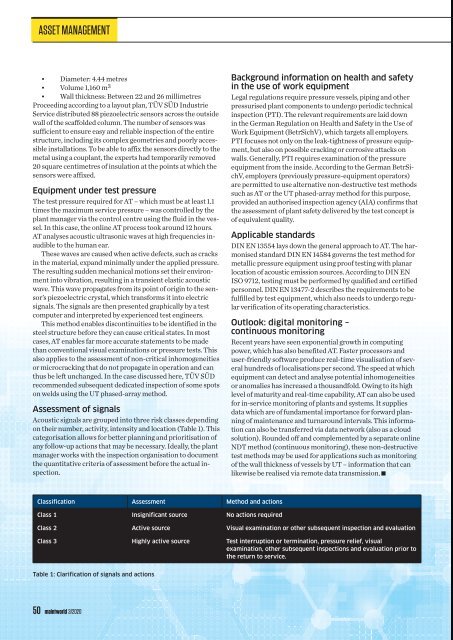Maintworld 3/2020
Maintworld magazine - maintenance & asset management Maintenance and reliability in the pandemic PEOPLE, THE MOST VALUABLE ASSET IN YOUR ORGANIZATION UNITED NATIONS OF AUTOMATION ČSPÚ 20 YEARS OF CZECH INDUSTRIAL MAINTENANCE
Maintworld magazine - maintenance & asset management
Maintenance and reliability in the pandemic
PEOPLE, THE MOST VALUABLE ASSET IN YOUR ORGANIZATION
UNITED NATIONS OF AUTOMATION
ČSPÚ 20 YEARS OF CZECH INDUSTRIAL MAINTENANCE
Create successful ePaper yourself
Turn your PDF publications into a flip-book with our unique Google optimized e-Paper software.
ASSET MANAGEMENT<br />
• Diameter: 4.44 metres<br />
• Volume 1,160 m 3<br />
• Wall thickness: Between 22 and 26 millimetres<br />
Proceeding according to a layout plan, TÜV SÜD Industrie<br />
Service distributed 88 piezoelectric sensors across the outside<br />
wall of the scaffolded column. The number of sensors was<br />
sufficient to ensure easy and reliable inspection of the entire<br />
structure, including its complex geometries and poorly accessible<br />
installations. To be able to affix the sensors directly to the<br />
metal using a couplant, the experts had temporarily removed<br />
20 square centimetres of insulation at the points at which the<br />
sensors were affixed.<br />
Equipment under test pressure<br />
The test pressure required for AT – which must be at least 1.1<br />
times the maximum service pressure – was controlled by the<br />
plant manager via the control centre using the fluid in the vessel.<br />
In this case, the online AT process took around 12 hours.<br />
AT analyses acoustic ultrasonic waves at high frequencies inaudible<br />
to the human ear.<br />
These waves are caused when active defects, such as cracks<br />
in the material, expand minimally under the applied pressure.<br />
The resulting sudden mechanical motions set their environment<br />
into vibration, resulting in a transient elastic acoustic<br />
wave. This wave propagates from its point of origin to the sensor’s<br />
piezoelectric crystal, which transforms it into electric<br />
signals. The signals are then presented graphically by a test<br />
computer and interpreted by experienced test engineers.<br />
This method enables discontinuities to be identified in the<br />
steel structure before they can cause critical states. In most<br />
cases, AT enables far more accurate statements to be made<br />
than conventional visual examinations or pressure tests. This<br />
also applies to the assessment of non-critical inhomogeneities<br />
or microcracking that do not propagate in operation and can<br />
thus be left unchanged. In the case discussed here, TÜV SÜD<br />
recommended subsequent dedicated inspection of some spots<br />
on welds using the UT phased-array method.<br />
Assessment of signals<br />
Acoustic signals are grouped into three risk classes depending<br />
on their number, activity, intensity and location (Table 1). This<br />
categorisation allows for better planning and prioritisation of<br />
any follow-up actions that may be necessary. Ideally, the plant<br />
manager works with the inspection organisation to document<br />
the quantitative criteria of assessment before the actual inspection.<br />
Background information on health and safety<br />
in the use of work equipment<br />
Legal regulations require pressure vessels, piping and other<br />
pressurised plant components to undergo periodic technical<br />
inspection (PTI). The relevant requirements are laid down<br />
in the German Regulation on Health and Safety in the Use of<br />
Work Equipment (BetrSichV), which targets all employers.<br />
PTI focuses not only on the leak-tightness of pressure equipment,<br />
but also on possible cracking or corrosive attacks on<br />
walls. Generally, PTI requires examination of the pressure<br />
equipment from the inside. According to the German BetrSichV,<br />
employers (previously pressure-equipment operators)<br />
are permitted to use alternative non-destructive test methods<br />
such as AT or the UT phased-array method for this purpose,<br />
provided an authorised inspection agency (AIA) confirms that<br />
the assessment of plant safety delivered by the test concept is<br />
of equivalent quality.<br />
Applicable standards<br />
DIN EN 13554 lays down the general approach to AT. The harmonised<br />
standard DIN EN 14584 governs the test method for<br />
metallic pressure equipment using proof testing with planar<br />
location of acoustic emission sources. According to DIN EN<br />
ISO 9712, testing must be performed by qualified and certified<br />
personnel. DIN EN 13477-2 describes the requirements to be<br />
fulfilled by test equipment, which also needs to undergo regular<br />
verification of its operating characteristics.<br />
Outlook: digital monitoring –<br />
continuous monitoring<br />
Recent years have seen exponential growth in computing<br />
power, which has also benefited AT. Faster processors and<br />
user-friendly software produce real-time visualisation of several<br />
hundreds of localisations per second. The speed at which<br />
equipment can detect and analyse potential inhomogeneities<br />
or anomalies has increased a thousandfold. Owing to its high<br />
level of maturity and real-time capability, AT can also be used<br />
for in-service monitoring of plants and systems. It supplies<br />
data which are of fundamental importance for forward planning<br />
of maintenance and turnaround intervals. This information<br />
can also be transferred via data network (also as a cloud<br />
solution). Rounded off and complemented by a separate online<br />
NDT method (continuous monitoring), these non-destructive<br />
test methods may be used for applications such as monitoring<br />
of the wall thickness of vessels by UT – information that can<br />
likewise be realised via remote data transmission.<br />
Classification Assessment Method and actions<br />
Class 1 Insignificant source No actions required<br />
Class 2 Active source Visual examination or other subsequent inspection and evaluation<br />
Class 3 Highly active source Test interruption or termination, pressure relief, visual<br />
examination, other subsequent inspections and evaluation prior to<br />
the return to service.<br />
Table 1: Clarification of signals and actions<br />
50 maintworld 3/<strong>2020</strong>

















